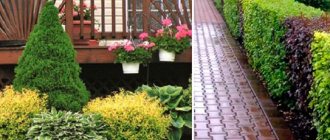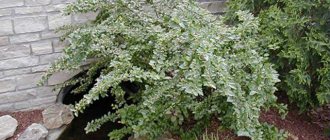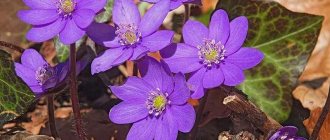- 4.1 Frames
The viburnum-leaved carp has become very popular in landscape design. The shrub is unpretentious to growing conditions. Throughout the season, the vesicular carp remains decorative. Carved leaves of different shades, lush light inflorescences and interestingly shaped fruits give the plantings a special charm. Pruning of the bladderwort is carried out to maintain the health of the plant and give the bushes shape.
Planting a bladderwort
The plant tolerates shade, but the color of the leaves fades over time when shaded, so it is advisable to plant this shrub in an open and sunny place. There are only two conditions for the soil - the absence of lime and the presence of drainage . Of course, the bladderwort will look more luxuriant on fertile, loose and fresh soil, but it will also look good on a substrate poor in nutrients. Another advantage of this plant is its resistance to air pollution, so it can be safely planted next to roads.
It is advisable not to use seeds for planting bladderwort, since the plant passes on its original leaf color only to part of the offspring. For initial planting, it is best to purchase plants with a closed root system from nurseries or garden centers, that is, grown in special containers. Such bushes can be planted at any time during the growing season (spring, summer or autumn). To plant, you need to dig a hole with a depth and a diameter of 50 cm, to the bottom of which peat-based garden soil or humus is added.
Planting a bladderwort
Subsequently, the bladderwort bush is carefully removed from the container (the main thing is not to damage the root ball or straighten it) and placed in the prepared planting hole. Then the hole is filled with fertile soil, and it is advisable to deepen the plant itself to 5 cm - this procedure will help give the bladderwort additional shoots from dormant buds.
After this, we water the bush generously with water and the “Kornevin” solution; as soon as the water is absorbed, we mulch the tree trunk circle (even simple dry soil is suitable for this). With this treatment, a surface crust does not form and the roots of the bladderwort will be able to receive the amount of air they need.
Pruning bladderwort in spring: how to form it correctly, diagram, video
Good day, forum users! I read about radical pruning. I understand, I approve, but I’m afraid. Due to my limited experience in gardening, I still want to play it safe, that is, share responsibility with the “experienced ones”))) Here’s the problem: . Let me clarify that this is a future hedge: bladderworts with hawthorns in a 3:1 ratio. The age of the fence is in the comments to the photo. I want to know: 1 – the reason for such “down to earth” nature of the vesicles, 2 – is it possible to cut them “to the stump” this spring, 3 – when is the best time to do this (in the Kostroma region), 4 – at what height?
Please enlighten me! P.S. The paper around is what is left of the weed protection by the fall (I covered it with cardboard and black film on top in the spring, I will sow the lawn).
| Sveta's mother |
| Kostroma |
| 21.04.2012 |
| 01:21:49 |
Mom Sveta, how tall is the fence planned? Please note that vesicles grow much faster than hawthorns (and they vary in size - from a medium-sized shrub to a tree - what type are you planting?), for a neat hedge you will have to cut it at least 3 times a season. But both hawthorn and bladderwort can, in principle, be kept at the “same size”.
Regarding your questions: 1. This is only 1 season, don’t worry, they will grow upward, and how! By the way, the width of your hedge, even with timely trimming, will take 50-70 cm at best, an unshaped hedge - multiply by 3. 2. You can cut, but not to a stump, of course. Leave 2-3 buds from each last year's growth, cut off the rest. 3. It’s time to cut, the plants are waking up.
Don’t forget to feed the plants after pruning, and feed them after each pruning in the future. It is better to mulch the strip under the hedge.
| dragonfly |
| Moscow |
| 21.04.2012 |
| 16:18:21 |
Reproduction of bladderwort
Bladderwort can be propagated by dividing the bush, layering or cuttings.
Reproduction of bladderwort by layering
Laying layering as a method of propagating vesicle carp gives very good results. For layering, you need to choose a healthy and strong shoot directed outward. Almost all leaves are removed from it, leaving only those at the top. Then we place the prepared shoot in a groove (the depth of the groove is up to 15 cm) and pin it to the ground (wooden staples are perfect for this purpose).
Reproduction of vesicular carp by layering. Photo from agronomu.com
This procedure must be carried out at the beginning of the spring season, so that the cuttings have time to take root in the remaining time before winter. It is important to moisten the soil in a timely manner during dry periods - without moisture, the fragile roots of the layer may die. At the end of the autumn season, young bladderwort bushes are separated from the mother plant and sheltered for the winter.
Propagation of bladderwort by cuttings
To propagate the vesicular carp by cuttings, it is necessary to use green shoots grown in the current year. Separated shoots should be soaked in any root formation stimulator (for example, in a solution of the same Kornevin) and planted in a substrate of sand with peat or river sand.
Propagation of vesicular carp by cuttings. Photo from agronomu.com
After planting, water the cuttings, then cover them with polyethylene. If there are few cuttings, then you can cover each of them separately with plastic bottles with the neck cut off. Subsequent care before the winter season consists of systematic moistening and ventilation. With the onset of winter, we cover the rooted cuttings, and in the spring we plant the shoots of the bladderwort in its permanent place.
Rules for creating a hedge from bladderwort: Suitable varieties - Review + Video
If you need to place a fence at your dacha or site, it is not necessary to build a brick wall.
You can create a fence from ornamental shrubs that will beautifully delimit the territory. A hedge made of bladderwort is one of the options for solving the problem. There are several varieties that can be used for such purposes. In addition to fencing the area, a fence made of bladderwort will beautifully decorate the area.
Characteristics of the bladderwort
A shrub of the Rosaceae family became popular in Russia not so long ago. More often this plant is cultivated in more stable climatic conditions, in North America. Bladderwort is an unpretentious shrub with good adaptation to a new location.
Red-leaved bladderwort is more common in our open spaces; it includes several varieties. It grows up to 3 meters in height, the crown grows densely, the branches are slightly drooping. The leaves are similar in shape to currant leaves, but more matte. Over the course of the season, the leaves change color from yellow to green, and in the fall they turn red.
Attention! Despite recommendations for planting bladderwort in the fall, in some regions it is safer to plant in the spring so that the plant is not caught by sudden frosts.
Among the advantages of vesicular carps can be noted:
- A variety of color colors of varieties, in addition, periodic changes in foliage color according to the seasons.
- Easy to care for and grow in open ground.
- Stable immunity to diseases and pests.
- High adaptability to any climate.
- Trimming the vesicle has a positive effect on its decorative qualities.
- In addition to being decorative, a hedge has practical qualities in the form of isolation from dust and prying eyes.
- During the growth process, the fence from the vesicular carp becomes an impassable obstacle.
Where and how to plant bladderwort
The shrub feels good in sunny places. For good growth and adaptation, it is important to choose suitable conditions for the life of the bladderwort. Due to its unpretentiousness, it can be planted in the shade, but it is better that nothing interferes with the light. The planting location is also determined by the condition of the soil. It must have good aeration and enough nutrients.
Planting is carried out in late spring or June, so the bushes will take root before the onset of frost.
Hedge planting scheme
To create a beautiful fence from bladderwrack, you need to think through a planting plan in advance.
The first step is the selection of seedlings; it must be careful and thoughtful:
- It is important to buy quality material; specialized nurseries are the right place to purchase.
- It’s good if there are documents that show the variety and characteristics of the plant.
- It is better to give preference to bushes in containers; they take root better and can be planted at the beginning of autumn.
- Externally, the seedling must be healthy, without signs of disease, rot or fungus.
The second is the place where the hedge is planted:
- The soil for planting must be well-drained.
- When underground water occurs, it is advisable to use drainage.
- If the soil is depleted, you should take care of fertilizers in advance.
After all the preparatory stages, you can begin planting the bladderwort:
- For a hedge, dig a trench to a depth of 60 cm and a width of 50-60 cm.
- The distance between vesicles is made at the rate of 3-4 bushes per meter of trench.
- After laying out the drainage, the soil is mixed with organic or mineral fertilizers.
- Having placed the seedlings with a lump of earth in a hole, they are covered with ready-made soil and trampled down.
- Finish planting by watering and mulching the soil with peat.
Important! At first, young seedlings need to be watered so that the soil is always moist.
Bush propagation methods
Cuttings are possible if there are strong shoots. The shoots of the bladderwort are cut so that each of them has buds. After soaking for an hour in a root formation stimulator, the cuttings are planted in a mixture of sand and peat under polyethylene. The soil mixture must be kept moist. They can be planted in open areas after a year.
by layering if there is a strong branch as low as possible to the soil. The foliage is removed along the length of the entire branch, leaving only the end. The cuttings are placed in a groove 15 cm deep and sprinkled with soil. With this method, the soil must be moistened without allowing it to dry out. It is better to carry out the procedure in early spring, so that new shoots will take root by winter.
How to care for a hedge
Let's consider the basic rules of care:
- be watered frequently. To adapt to a new place, roots need moisture. Until complete rooting, the bladderwort is watered 3-4 times a week, then less often and only during drought. If it rains regularly, watering is completely unnecessary.
Important! Land with a high clay content should receive less water; moisture stagnates in it, which leads to rotting of the roots.
- Fertilizers for hedges are consumed many times faster due to dense planting. To fertilize plantings of this kind, a certain schedule is needed. Before spring cutting, you need nitrogen, or saltpeter with mullein and urea. This composition is diluted in 20 liters of water and watered on the bladderwort bushes. In the fall, mineral supplements are suitable; they will become a preventive measure for diseases.
Important! In order for microelements to better penetrate the soil and reach the root system, the soil is loosened before applying fertilizers.
- Compost can be used as mulch; it will saturate the soil with useful elements.
When to trim your bladderwort hedge
In order for the hedge to have a beautiful appearance, it is necessary to regularly form the crown. This procedure helps increase the strength of the root system. The timing of pruning depends on the age of the bladderwrack bushes. The bushes need to be trimmed for the first time in the spring after planting the seedlings. During this period, only 15 cm is left from the height of the bush. The second time pruning is carried out a year later, removing 50% of the total green mass of the bush. The sides are shortened by 10 cm; over the summer, the bushes will grow up to 35 cm of shoots around the circumference.
Bladderwort care
Bladderwort is an unpretentious plant to care for, although some features should be taken into account. The shrub itself lives up to a quarter of a century and develops rapidly during the growing season. Under good conditions, in one year the vesicular carp can add up to 40 cm in both height and width. Therefore, to give the bush the desired shape and stimulate branching, careful pruning is necessary.
The plant endures the procedure itself steadily and painlessly and then quickly grows new shoots. A big plus of the shrub is its excellent winter hardiness; in the middle zone it overwinters without shelter, and only in severe frosts can the tips of the shoots be damaged.
Seed pods of the vesicular carp variety 'Luteus'
Trimming
Bladderwort needs both sanitary and bush-forming pruning. Sanitary pruning is carried out in the spring and consists of trimming broken and frozen branches. Well, formative pruning is necessary so that the bush does not play pranks and grows as you need











